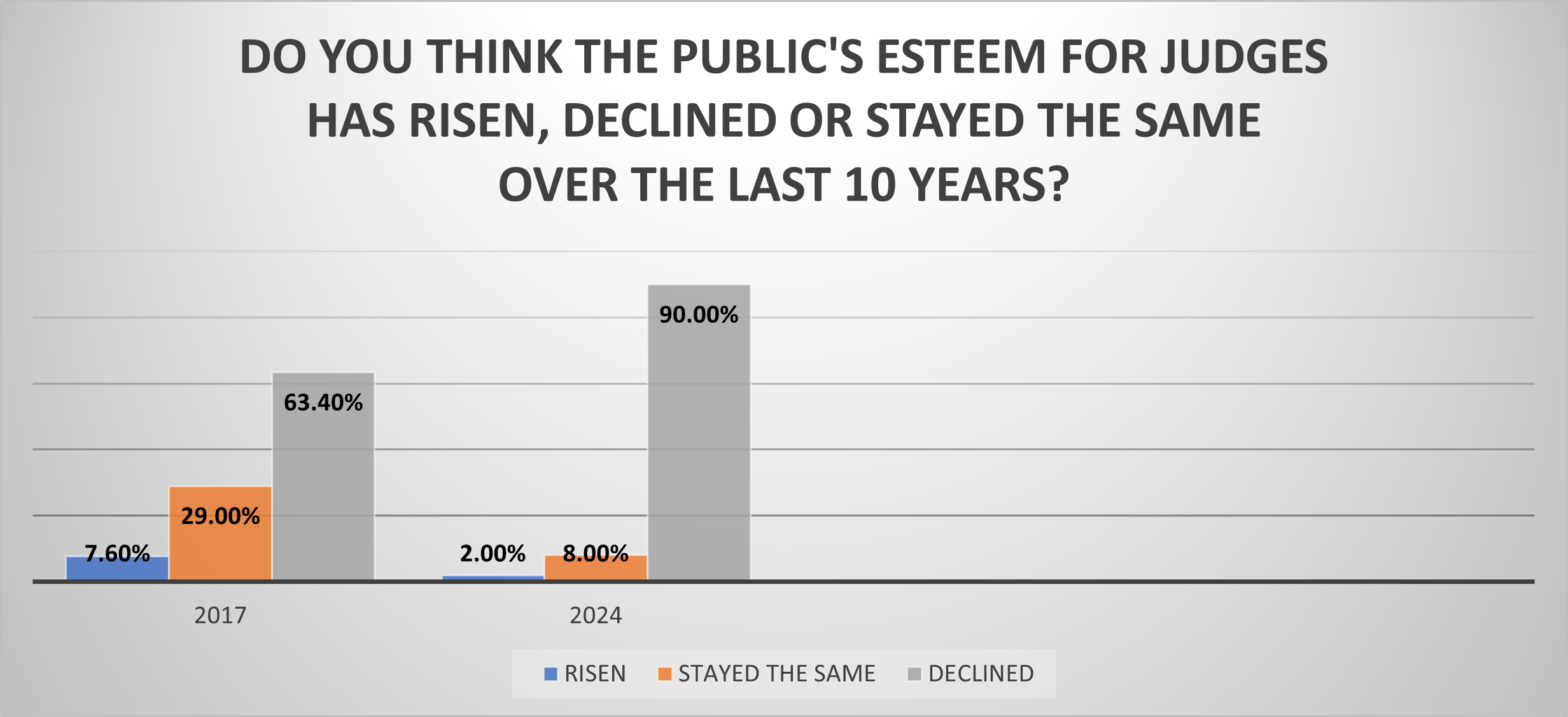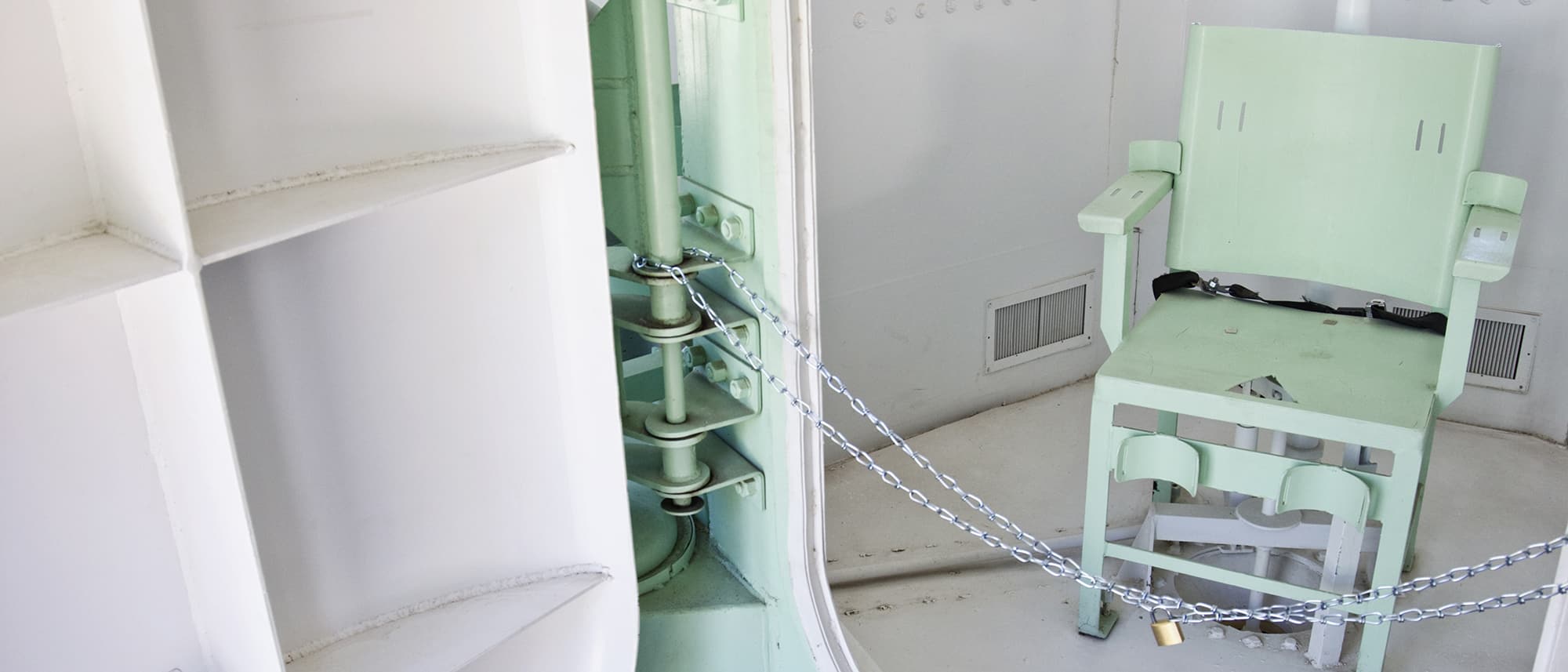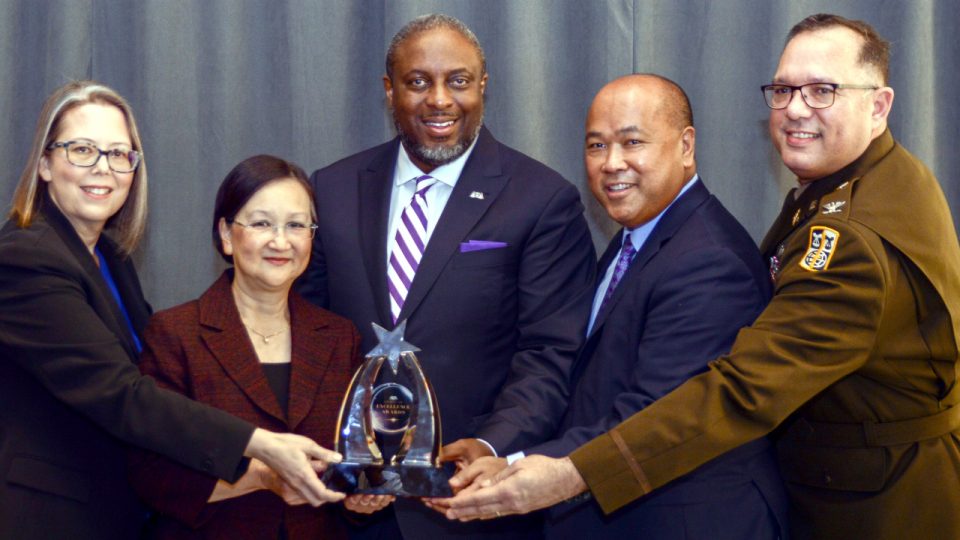
By Colonel Linda Strite Murnane
By Linda Strite Murnane, Colonel, USAF, Ret.
I served my last 10 years of a 29.5-year military career as a military trial judge. A day in my life usually began with packing a suitcase. U.S. military trial judges are assigned through a system of circuits or centralized location, and are then sent to the base at which the case will be tried to preside over the trial.
Each week began a new adventure, beginning with a trip to the nearest commercial airport or to the nearest airlift terminal on a military installation. I certainly had some exciting travel opportunities. While assigned as the chief circuit military judge for Europe, for example, I supervised one other military judge. Between the two of us, we were responsible for presiding over the military trials of U.S. airmen assigned anywhere in Europe, Southwest Asia, and Northern Africa. Because of the dates of my assignment in that role, between 2000 and 2003, my fellow judge and I became responsible for the deployed trials for U.S. airmen assigned at operational bases supporting Operations Iraqi and Enduring Freedom. For me, that meant trials at military sites in Oman, Qatar, and Saudi Arabia during the conflict.
To catch a flight to get to the combat zones, I might find myself on a military transport plane or a commercial flight—but whatever flight I might get, it would be exciting. One of my deployed trial experiences occurred the week before my daughter was scheduled to graduate from college. I flew into the deployed location on a contract flight. The projected return flight was scheduled for a date that would have meant that I would miss getting home for her graduation.
Fortunately for me, there was a C-17 cargo flight leaving from the deployed location that would take me as far as Frankfurt, Germany, which is where I was to catch my commercial flight home for leave. It was a 17-hour flight, with cargo all around me. There were no reclining seats and no movie, and the only hot meal was the opportunity to heat up a frozen TV dinner in a microwave on board. It was a hot meal, though, and that was really a welcome treat. If I wanted to take a bit of a nap during the flight, I rolled out my gear and laid on the rollers on the floor. It wasn’t exactly first-class accommodations, but it got me to Frankfurt in time to catch the flight home—and being at my daughter’s graduation meant everything to me.
A courtroom for a military judge might be a modern and well-furbished facility, or, as was the case in deployed locations, it could be a tent, or a hardened aircraft hangar. If I was fortunate enough to be at a military installation outside the combat zone, I would be housed either in the temporary lodging facilities on the base or in a hotel near the installation. When I was deployed, my accommodations were a tent, with a community bathroom a short hike away.

At a deployed location for one trial over which I presided, the courtroom was in a converted aircraft hangar. The trial bench was a folding oblong table covered with a blue tablecloth. Someone had painted a wombat, a mascot for the unit, on the wall of the hangar. We covered that with a white cloth during the trial. The U.S. flag and Air Force emblem were displayed in the courtroom, which had folding metal chairs for the judge, court reporter, witness, bailiff, and counsel, as well as spectators.
That particular facility had no indoor latrine facilities, and so the latrine was a portable toilet, painted camouflage brown, against the sand. On the day of the trial, there was a serious dust storm and so finding the latrine, and getting to it, was a true test of one’s endurance.
A day in the life of a military trial judge would ordinarily begin with traveling to the location of the trial, checking into temporary lodging, and then meeting with the parties litigating the case. The judge might also spend time meeting with the court reporter, who is ordinarily a civilian employee on staff or a paralegal court reporter at the legal office, which is usually where the courtroom is located. In some instances, such as trials conducted in a deployed environment such as occurred during Operations Iraqi and Enduring Freedom, there might be a paralegal staff member or a civilian court reporter who deployed to support the trial in the combat area. During deployed trials at which I presided on five occasions, I had either a dedicated civil service court reporter who traveled with me to the location or, more often, a military enlisted member whose paralegal duties included training as a court reporter.
A military trial judge would spend part of the first day resolving any motions that remained before empaneling a panel to hear the case. Many motions are resolved in writing, before the military judge travels to the trial site. However, those that require further argument, or those that have arisen since the judge started the journey for the trial, will be resolved on-site, usually before the panel (similar to a jury in civilian trials) is convened. When trying cases at stateside or overseas bases outside the combat zone, military judges have access to the very best of technology and resources for research and for preparing decisions on motions. In the combat zone, during the years I served, access to Internet resources was less certain. With the creation of the electronic military bench book, judges began to travel with laptops and with disks containing as much relevant case law as they could store and carry, just in case the Internet resources were needed for higher-priority mission requirements in the field.
At one deployed location, the judge’s “chamber,” where I hung my robe and considered my decisions, was outdoors and covered by a camouflage mosquito net area. Because it was warm—very warm—at this location, being outdoors with some fresh air and sometimes a breeze was actually a welcome relief.
At the time that a case is referred to trial, a panel of officers is assigned to hear the case. If requested by the defendant, referred to as the “accused,” a military trial judge may hear the case “judge alone.” The judge will inquire with the accused whether the request to be tried by a military judge sitting alone is voluntarily made, and if the accused understands that the judge will hear the evidence, decide guilt or innocence, and also decide the sentence in the case. With the knowing and voluntary waiver of the right to panel members, the judge hears the case alone.
An enlisted accused also has a right to request up to one-third of the panel be composed of enlisted members along with commissioned officers if the accused wants the case heard before a panel. For cases tried by a panel, the senior member of the panel serves as “president” of the court, with duties much like those of a jury foreman. Death penalty cases in military courts may not be tried by judge alone and must be heard by a panel.
During trial days, a military trial judge will hear evidence, rule on the admission of exhibits, and at the conclusion of the evidence, discuss instructions to be given to the panel on the law to be applied in the case.
Meanwhile, during lunch breaks and overnight, it is entirely possible that a military trial judge is performing duties that may be less related to the role of military judge, and perhaps more related to the obligations the individual has as a military officer.
Military trial judges compete for promotion within the military using the same general concepts and principles applied to their nonlegal counterparts in the military. While in the civilian sector, advancement on the bench may be through election, appointment, or other means, in the military, promotion leads to advancement, though not always on the bench. In fact, for most military judges, the promotion track arises in a very different way than it does for civilian judicial colleagues. As a military judge, you may spend one tour, usually three years, on the trial bench, and then move back into a position either in a headquarters staff as a judge advocate general (JAG) or as a staff judge advocate, the senior legal advisor to a commander of an installation or unit. In my own career, I was fortunate to have served four consecutive tours as a military trial judge, including two assignments as a chief circuit military judge.
To continue to advance in their military career, military judges are expected to meet a number of additional requirements that their civilian counterparts are not ordinarily subject to complete. First, there is the annual physical fitness assessment. They are required to meet a physical fitness requirement, which includes various tests such as pushups, sit-ups, and an aerobic component. So, any day in the life of a military judge probably includes a visit to a fitness facility or track, though whether an individual finds time to do that depends on the demands of that day’s court hearings. This was never my strength, given that I had suffered a serious knee injury when I was a captain, so while I knew where the fitness centers were on any base, and I usually packed clothes with the intention of getting to the track or getting to the fitness facility, more often than not, I decided I had more important things to do.
Military judges are also required to maintain their professional development as officers, and so they are expected to complete courses designed to improve their skills as leaders, officers, and members of the military. That may include courses like war college (Air War College, Army War College, and so forth), which are completed either in residence during a year off the bench or by correspondence, during breaks, and at night after duties on the bench are completed. Successful completion of squadron officer school, officer staff college, and war college at various increments in an officer’s career are vital to advancement in military grade. I was fortunate to have previously completed my military professionalism courses. This took a good deal of time and commitment but was easier by far than trying to do it while on the trial bench.
The military also imposes an “up or out” policy. As a result, failure to achieve promotion after two attempts will bring an officer’s career to an end.
In addition to completing coursework for development of leadership skills, a military judge, like most judges, has the “paperwork” drill that has to accompany any trial to which he or she is detailed for service. The military services have significant reporting requirements for all of their activities, including reports to Congress on many different aspects of the military justice process. With the recent highlight on sexual assault in the military, there are statistical reporting requirements that military judges meet through filing of case reports at the end of each trial. These reports are compiled through the regional circuit offices and forwarded to Congress in accordance with established or ad hoc reporting dates depending on the subject.
For individuals who also serve as military supervisors, a day in the life of a military trial judge also may involve reviewing with another military judge, or paralegal member of the circuit office, any performance issues that might impact on annual appraisals. Annual appraisals for enlisted, civilian, and commissioned members of the armed forces are important components of pay, promotion, and other development assessments. While in Europe as the chief circuit military judge, I was responsible for the annual appraisal of one military judge and one paralegal. I was also responsible for the maintenance and upkeep of the European Circuit plant and facility, computer equipment, supplies, and like logistical requirements for all circuit staff including circuit prosecutors and defense attorneys as well as the judges. While in the Eastern Circuit (Washington, D.C.), I was responsible for the annual appraisal of four military trial judges serving on active duty and two reserve military judges as well as two paralegal staff. I also had plant and facility responsibilities at that circuit.
Each year, a chief circuit judge is required to submit expense reports. They are also called upon to submit budget input as part of a composite submission made through the service branch chief judge to ensure adequate funds to meet the requirements related to operating a circuit. My responsibility for managing the budget generally involved travel allocations of around $250,000 annually, plus the costs associated with upkeep of the circuit offices.
Military judges are encouraged to participate as members of professional organizations. Participation in organized bar activities, such as the American Bar Association (ABA), American Inns of Court, National Association of Women Judges, and like organizations provide networks that enable them to continue to develop their skills as members of the legal profession. Currently, there are present and former members of the military who hold active leadership roles in the Judicial Division and other key entities of the ABA. These professional affiliations not only make these judges better at their current craft, but also will help when they transition from their military service to a civilian career. With a current limitation on military service of 30 years, and graduation from law school generally being around age 26, military members who serve a full career find themselves in the job market at around age 56.
Military judges often choose to serve as members of an administrative law judiciary, where they are able to continue their service and use their highly honed judicial skills through a government organization. Occasionally, a military trial judge will separate and run for a judicial position in his or her home state, or be considered for a federal appointment. However, because military members are ordinarily reassigned every two to three years to places outside their home state, and because their involvement in political events is limited under the Hatch Act, military judges often do not have the needed contacts to make them viable candidates for these types of key positions.
At the end of a week, the life of a military judge returns to the other end of the spectrum, home and family life. Often the judge can get home on Friday or, if fortunate, before Friday. When they are home, they are able to spend time with family, made more challenging with the frequent separations and the added obligations military life brings to the military member’s partner. I recall that one year I spent well over 200 days on the road. When you hear that a military family also serves, it is good to remember what those family members who remain behind do to ensure that the military member can do the job he or she has been sent to do.
Military trial judges serve willingly and with pride, but it is not a profession for those looking for an easy or routine life. The adventures are endless, but the demands are high. That is the bottom line about a day in the life of a military trial judge.

RENO, NV (PNS) – As they eye their inaugural football season this fall, the Gaveliers have question marks...

In what may reflect a devastating blow to the morale of the judiciary, 9 out of 10 judges believe the publi...

RENO, Nev. (Jan. 26, 2024) — The nation’s oldest, largest and most widely attended school for judges �...

RENO, Nev. (Feb. 7, 2024) — National Judicial College President & CEO Benes Z. Aldana received the Am...

It’s the bear, by a clear majority. A bear to be called Bearister. January’s Question of the Month* ...
